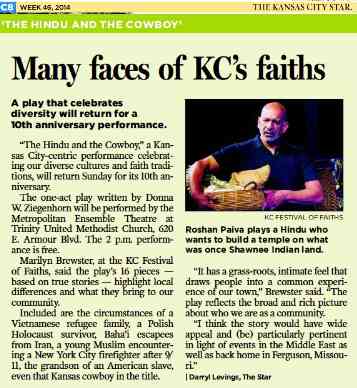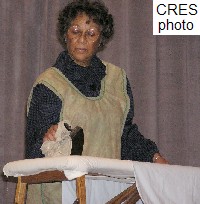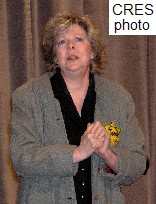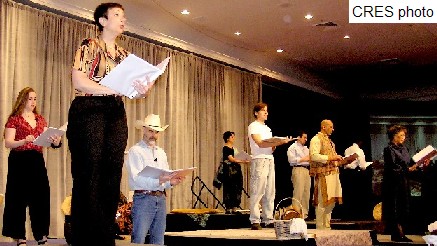The Hindu and the
Cowboy
and Other Kansas City
Stories
winner of awards from the
Crescent Peace Society, Dialogue Institute of the Southwest, Greater Kansas
City Interfaith Council, and the Missouri Association of Social Work. and
featured by
At
Harvard University's Pluralism Project
Its
own website
with
updated performance history
Recent coverage
2014 November 14
‘THE HINDU AND THE COWBOY’
Many faces of KC’s faiths

A play that celebrates diversity will
return for a 10th anniversary performance.
“The Hindu and the Cowboy,”
a Kansas City-centric performance celebrating our diverse cultures and
faith traditions, will return Sunday for its 10th anniversary.
The one-act play written
by Donna
W. Ziegenhorn will be performed
by the Metropolitan Ensemble Theatre at Trinity United Methodist Church,
620
E. Armour Blvd. The 2 p.m.
performance is free.
Marilyn Brewster, at the
KC Festival of Faiths, said the play’s 16 pieces — based on true stories
— highlight local differences and what they bring to our community.
Included are the circumstances
of a Vietnamese refugee family, a Polish Holocaust survivor, Baha’i escapees
from Iran, a young Muslim encountering a New York City firefighter after
9/ 11, the grandson of an American slave, even that Kansas cowboy in the
title.
“It has a grass-roots, intimate
feel that draws people into a common experience of our town,” Brewster
said. “The play reflects the broad and rich picture about who we are as
a community.
“I think the story would
have wide appeal and (be) particularly pertinent in light of events in
the Middle East as well as back home in Ferguson, Missouri.”
| Darryl Levings, The Star
A collection of news
stories and reviews
through April, 2004
1. Program description
2. Harmony
luncheon performance
3. Meet the
playwright
4. Robert
Trussell review in The Kansas City Star.
5. Steve Penn commentary
in The Kansas City Star.
6. Vern Barnet's column in
The
Kansas City Star.
|
| Book a performance of
The Hindu and the Cowboy for your organization! From a 50-minute play to
a complete two-act show, your needs can be accommodated: a great experience
for your school — business — organization — conference —
religious group — and more! |
1. Program
Description
The Hindu and the Cowboy and Other Kansas
City Stories is based on interviews with Kansas Citians of many diverse
traditions, the result of the Mosaic Life Stories Project, a process undertaken
in 2002 by volunteers inspired by both the need for firsthand interfaith
understanding and by belief in the power of story in dramatic form. The
idea was sparked by the Gifts of Pluralism conference hosted by the Center
for Religious Experience and Study (CRES) and co-sponsored by Kansas City
Harmony and NCCJ. The conference fell by chance on the heels of September
11, 2001.
Seven individuals involved
in the Stories Project were trained to interview, collect and transcribe
stories. They collected approximately 80 stories through personal interviews
and story-telling circles. The transcribed stories fill three two-inch
ring binders. Scriptwriter Donna Ziegenhorn designed the project and wrote
the play based on her experience in story based performance. It is scripted
from selected stories and is performed by local actors in the form of a
staged reading. The names of the original storytellers have been changed
in the script. The Stories Project Task Force anticipates creating more
plays from the original material collected, as well as expanding the base
of persons interviewed.
The Stories Project has encouraged
people to come forward and tell the stories they have lived, the stories
that have affected them in a visceral way. All generations, including youth,
and all major faiths have been involved in the storytelling. To date, individuals
have been interviewed from the following faith traditions: Native American,
Bahá'í, Christian (Protestant and Catholic), Hindu, Islam,
Judaism, Pagan, Sikh Dharma, Sufi, Unitarian Universalist, Zoroastrian,
Jain, and non-affiliated as well.
The stories, which reflect
tragedy, healing, humor, and reconciliation, are personal and unique. Together
they present a rich and varied face of Kansas City. The stories show that
people who join the community add their personal histories to those whose
families have lived in Kansas City for generations. The project is a tribute
to the changing identity of the metropolitan area. —Vern Barnet |
| 2. Harmony
Luncheon
 The
2004 April 15 Harmony Luncheon at the Marriott Hotel was a delight.
In addition to the delectable melon soup, the refreshing oriental salad
and the scrumptious desserts (I had the chocolate), the staged reading
of The Hindu and the Cowboy and Other Kansas City Stories offered much
needed nutritional value to those who attended. What a wonderful collection
of tales, struggles, joys and memories! Each story contained pivotal moments
in which the storytellers reached for something beyond themselves and found
it to exist. Collectively, the unique moments in each personal story
formed mirrored images of our own pilgrim’s progress toward that which
is sacred. The
2004 April 15 Harmony Luncheon at the Marriott Hotel was a delight.
In addition to the delectable melon soup, the refreshing oriental salad
and the scrumptious desserts (I had the chocolate), the staged reading
of The Hindu and the Cowboy and Other Kansas City Stories offered much
needed nutritional value to those who attended. What a wonderful collection
of tales, struggles, joys and memories! Each story contained pivotal moments
in which the storytellers reached for something beyond themselves and found
it to exist. Collectively, the unique moments in each personal story
formed mirrored images of our own pilgrim’s progress toward that which
is sacred.
Scriptwriter Donna Ziegenhorn
managed to successfully weave different tales as artfully as one would
weave different colored threads into one beautiful tapestry. Through the
voices of talented actors, each individual story was left to dangle while
threads of other stories were worked into the design. Then, one by one,
the audience was brought back to capture the threads that dangled. Memories
were woven to completion. Joy overcame sorrow. Past wounds
morphed into attitudes of resolve in order to improve present lives.
In the end, as foretold through
the writings of the Hebrew prophet, Zephaniah, each storyteller stood “shoulder
to shoulder, calling on the name of YAHWEH” in unison for the sake of harmony.
The “many tongues” stood together as “one tongue.”
I must admit that as I watched
and listened, my throat closed on several occasions as I fought back tears.
Being a person who prays unceasingly for an end to hatred and prejudice,
I am unable to experience the ideal of unity without internally welling
up to the point of joyous overflow. I so strongly believe that the world
is starving for this form of honest communication and spiritual edification.
As a newcomer to the Kansas
City area, I’m thrilled to know that organizations such as KC Harmony and
CRES are not only in place but fully functioning! The efforts made toward
respect and understanding between religious and ethnic cultures can only
bring about standing ovations throughout the city. Hopefully, the
small pebble that has been thrown into a pool of water will have an ever-widening
effect. What better place to toss a pebble into a pool than in the
very heart of the United States!
Personally, I wish to cast
my vote for The Hindu and the Cowboy and Other Kansas City Stories, to
spread across the nation as a staged presentation — but why stop there?
Published in book form, this valuable collection of spiritual journeys
could become a best-seller among teachers, clergy and interfaith workers
who choose to make a difference in their respective communities. Pluralism
in action, word and deed need not be a foreign or unobtainable concept.
A respectful celebration of differences can ultimately be assimilated by
the human mind, but first it must be shown to exist! — May God continue
to give us the desire to whet appetites. —Carol Wimmer
|
| 3. Meet
the Playwright
Donna Woodard Ziegenhorn bases her work
on bringing the lived experience to dramatic form. She says, “we clarify
and claim our selves – as individuals and as communities – when we share
our stories.”
Long a journalistic and promotional
writer, Donna turned to writing and presenting her own life stories in
monologues, including Suppressed Desire and other Nearly True Tales and
Starting with Red, presented at The Writer’s Place and for private audiences.
Applying the same concept
on a community basis, she scripted a play, Between the Arrows, for a conference
of international volunteers at the University of Denver. Working with Chicago-based
Community Performance Inc, she has been involved with designing and implementing
story-based performances for communities in Colorado, Florida, and Georgia.
Developing a project specifically aimed to hold up religious and cultural
stories has been a dream. It is truly the product of a rich and diverse
effort on the part of many members of the community who share in the year-and-a-half
long process.
Donna is associated with
Kansas City Friends of Jung and the Center for Reli-gious Experience and
Study as a former board member. She convenes the Kansas City LifeWriters
and is completing a master’s degree this spring at the University of Missouri-Kansas
City.
Family lore has it that her
great-great grandmother, Emmaline, was a Spanish princess, left as an infant
during her regally clad birth-parent’s overnight stay at the ferry-keepers
inn on the Great Satilla River near Savannah.
The Performance Team
Caroline Baughman (Grandmother;
Sufi)
Diane Bulan (Hindu woman)
Betty Admussen (Native American Woman)
George Forbes (Preacher)
Cheryl Hood (Naysa)
Tobias Lofton (Ahmad; the Sikh)
Roshan Paiva (the Hindu Man)
Geneva Price (Odelia; Singing Grandmother)
Royal Scanlon (Cowboy)
Linda Sher (Ahmad’s Mother)
Charles White (Christian; Reader; Priest)
Sam Wright (Luis; Monk; Wiccan)
Frank Higgins (Producer)
Ernest L Williams (Director) |
Posted on Wed, Apr. 14, 2004
4. Hindus,
cowboys and Kansas City
Play tells stories about tolerance and
prejudice,
gathered from people here

By ROBERT TRUSSELL
© The Kansas City Star
“One thing I found really moving about
the script and the stories were the amazing things individuals who might
sit at the desk next to us have gone through because of their faith or
ethnicity, just to be in Kansas City. I don’t think people in general appreciate
that.” — Diane Hershberger, executive director of Kansas City Harmony.
A lot of us think we know
all about diversity, the evils of prejudice and the virtues of tolerance.
But we may not know as much
as we think.
That, at least, is the view
of Diane Hershberger, executive director of Kansas City Harmony, a nonprofit
organization devoted to building bridges. And that basic idea underpins
a play, The Hindu and the Cowboy and Other Kansas City Stories, which will
be performed today at Harmony’s annual luncheon at Marriott Muehlebach
Tower.
The script, written by Donna
W. Ziegenhorn of the Mosaic Life Stories Project, is based on actual life
stories gathered from Kansas City area residents by a team of volunteer
interviewers. The play, which has had private readings at the Coterie Theatre
and the Bruce R Watkins Cultural Center, relates diverse life experiences
selected from about 80 that were collected for the project. The interview
subjects followed a variety of faiths, including Christianity, Judaism,
Islam, Hinduism and Native American religions.
“There’s lots of movement,”
Hershberger said. “A person’s story doesn’t begin and end at the same time
they are on the stage. Stories weave in and out. At the beginning there’s
a lot of discussion about the lines that divide us in this city — and then
the individual stories begin to be told.”
The actors for today’s performance
are a mix of professional and community-theater actors, students and local
activists. Among them are George Forbes, a veteran of productions at the
Coterie and Theatre for Young America; Diane Bulan, an acting teacher who
has appeared in professional and community productions; singer Royal Scanlon;
and KCUR-FM announcer Linda Sher.
The play’s documentary approach
connects it to an increasingly important style of theater that in recent
years has yielded such fact-based dramas as The Laramie Project, which
explored the aftermath of a gay university student’s murder in Wyoming,
and The Exonerated, which tells the stories of men and women who were sentenced
to death but freed after new trials, DNA tests or other circumstances.
Hershberger thinks The Hindu
and the Cowboy, like those shows, serves a basic need.
“Those of us who feel we’re
in the majority don’t always see things that divide us,” she said. “I can
think of a specific story when I was in a different workplace. It never
occurred to me that a man I worked with was Hindu until years later when
I saw him at an interfaith event. It was a part of him I didn’t recognize.
I probably said ‘Merry Christmas’ to him.
“One thing I found really
moving about the script and the stories were the amazing things individuals
who might sit at the desk next to us have gone through because of their
faith or ethnicity, just to be in Kansas City. I don’t think people in
general appreciate that. One of the stories is about a monk who was hung
upside down above a fire to be tortured. Now this is a person you might
see at Wal-Mart, and you would never know.”
Hershberger, aware of how
dull corporate luncheons can be, said Harmony always tries to do something
different at its annual get-together.
“Last year we had a one-woman
performance,” she said. “We try to bring the mission of the organization
to people through very nontraditional luncheon ways. This play is in that
line. People do remember when they come to the Harmony luncheon.”
In other words, even a sympathetic
audience might learn something from The Hindu and the Cowboy.
“Many of us think we understand
and appreciate diversity, but most of us don’t understand the full breadth
of it and many of us don’t understand our own prejudices and biases,” she
said. “When we’re faced with something totally different — sexual orientation,
for example, which does come up in the play — sometimes we’re not so comfortable
with that aspect of diversity.”
 The play’s creation was an outgrowth of the Gifts of Pluralism conference
in 2001 given by CRES, a nonprofit group whose name stands for Center for
Religious Experience and Study. The project was sponsored by CRES and Harmony.
The play’s creation was an outgrowth of the Gifts of Pluralism conference
in 2001 given by CRES, a nonprofit group whose name stands for Center for
Religious Experience and Study. The project was sponsored by CRES and Harmony.
Today’s performance is directed
by Ernest Williams and produced by Frank Higgins, a Kansas City playwright
who helped condense the play to a shorter format for the purposes of the
luncheon.
At the moment, Hershberger
said, a group of volunteers has embarked on a similar effort. Stories are
being collected from Kansas Citians related to the school desegregation
case. She said that effort was in an early stage.
Tickets to today’s luncheon,
scheduled from 11:30 a.m. to 1 p.m. (following an 11 a.m. reception), are
available for $50. Go to www.kcharmony.org or call (816) 231-1077.
To reach Robert Trussell,
theater critic, call (816) 234-4765 or
send e-mail to rtrussell@kcstar.com |
Posted on Tue, Apr. 06,
2004
5. COMMENTARY
New play celebrates diversity
By STEVE PENN
© The Kansas City Star
 A
college student from Kansas City explains what it was like being a Muslim
living in New York just after 9-11. A
college student from Kansas City explains what it was like being a Muslim
living in New York just after 9-11.
A former Tibetan
Buddhist monk who now lives in Kansas City once sought freedom by fleeing
to the Himalayas.
The stories behind
these ordinary yet extraordinary people are sometimes awe-inspiring — and
are reflective of the religious diversity found in Kansas City .
Increasing respect
for religious differences is the goal behind a powerful new play titled
The Hindu and the Cowboy and Other Kansas City Stories.
The two-act drama
will open April 15 at the Kansas City Harmony luncheon at Muehlebach Tower
of the Kansas City Marriott Downtown. Tickets are $50.
Donna Ziegenhorn
designed the project and wrote The Hindu and the Cowboy.
“This idea has
been growing in my mind for a number of years,” Ziegenhorn said. “It really
comes out of my belief in the power of the lived experience. It’s the power
of story in dramatic form.”
The project is
the inspiration of the Mosiac Life Stories Task Force, a volunteer effort
started in 2002 to promote interfaith diversity.
To create her
work, Ziegenhorn relied on seven researchers who collected and transcribed
80 interviews based primarily on one-on-one interviews with people throughout
the area.
Individuals interviewed
were American Indian, Bahá'í, Christian, Hindu, Muslim, Jewish,
Pagan, Sikh, Dharma, Sufi, Unitarian, Universalist, Zoroastrian and Jain.
The title of
the play derives from one of its stories. When the Hindus were building
their temple in the 1980s in Shawnee, the temple’s president and his wife
went to the site and saw what appeared to be a cowboy with a gun sitting
on a horse. Researchers interviewed the cowboy, who explained that he was
born in Shawnee and was dedicated to protecting the land around the temple.
“The cowboy is
looking out, making sure nobody takes advantage of the Hindus or bring
harm to the temple,” Ziegenhorn said. “The Hindus are wondering, ‘Who is
this guy?’ ”
By the end of
the play, the audience understands the importance of their connection.
Another story
in the play deals with the experiences of Ahmad, a Muslim raised in Kansas
City. Ahmad was attending Columbia University in New York just after the
Sept. 11, 2001, attacks when he learned what it was like to be harassed
and stereotyped.
One day, Ahmad
was sitting at a restaurant when several firefighters walked in.
“They stand there
in the doorway looking at me real closely, checking me out,” Ahmad says
in the play. “Then they approached our table. And one of them says, ‘I
want to see your head under the pavement.’
“Now people are
afraid of me. They’re keeping their eyes on Ahmad, every minute.”
Another story
centers on a Holocaust survivor who lives in Kansas City.
“When I was 14,
everything changed,” the woman says. “The SS came to Poland with their
motorcycles and tanks. They came to my house. … They took my 18-year-old
sister. She’s delicate and fragile. … Me, I’m strong and healthy. … I went
to the camp in her place.”
Some people look
down on cultures and religions they don’t understand. Fortunately, Kansas
City Harmony and a few other organizations are dedicated to eradicating
that ignorance.
This extraordinary
new play could become an effective tool in that quest.
To reach Steve Penn,
call (816) 234-4417
or send e-mail to spenn@kcstar.com
|
posted Wed, Sept. 17,
2003
6. FAITHS AND BELIEFS
Council achieves much
By VERN BARNET
© The Kansas City Star
For the past three years, the Kansas City
Interfaith Council has gathered on September 11.
In 2001, media were invited
to hear members of the council announce The Gifts of Pluralism conference
planned for that October. As events unfolded on the TV monitor in the room,
Council members expressed deep commitment to one another and to the city
to foster interfaith understanding, and the Muslims pointedly condemned
the hijacking of their faith.
The conference was held as
planned. Over 250 people from every faith group from A to Z — American
Indian to Zoroastrian — participated in the two-day assembly at Pembroke
Hill School. Many relationships were developed that have strengthened the
community, and new programs have emerged.
One of them is Mosaic, which
includes an interfaith book club, a “Passport” program for visiting houses
of worship of various faiths, and a “stories project.”
 This project involved interviewing over 60 people, from a now-elderly Jewish
survivor of a Nazi concentration camp to a young Muslim. The interviews
have been fashioned into a play, tentatively called The Hindu and the Cowboy
and Other Kansas City Stories, with a staged reading Nov 2 at the Bruce
Watkins Center. Understanding one another’s lives in the context of our
faiths is a way to liberate ourselves from the fear the terrorists wished
to instill within us.
This project involved interviewing over 60 people, from a now-elderly Jewish
survivor of a Nazi concentration camp to a young Muslim. The interviews
have been fashioned into a play, tentatively called The Hindu and the Cowboy
and Other Kansas City Stories, with a staged reading Nov 2 at the Bruce
Watkins Center. Understanding one another’s lives in the context of our
faiths is a way to liberate ourselves from the fear the terrorists wished
to instill within us.
In 2002, the Council observed
the first anniversary with a day-long schedule to place 9/11 in a spiritual
context. Members of the Council brought waters from their individual faith
communities, from water collected from KC area fountains, and from the
rivers and oceans of the world, to honor both the tears flowing from the
tragedy and the refreshment and cleansing power of our faiths. Network
CBS-TV broadcast these and other local efforts as model interfaith approaches
for the rest of the nation.
In 2003, last Thursday, the
Council members met and exchanged stories about how these two years affected
them and their communities. The reports were filled with emotion. The assessments
were mixed. Pride in the area’s residents’ reaching out to one another
and learning about others’ faiths was offset by the corrosive impact of
economic priorities and international concerns.
Despite misunderstandings,
Muslim leaders have been especially vigorous in reaching out to Jewish,
Christian and other reli-gious communities. Their strong allegiance to
American democracy and ability to correct misrepresentations of their faith
show us that we are all together as we seek a world of mutual respect and
promise.
We still have more work to
do. We must live our faith more deeply.
Vern Barnet does interfaith work in Kansas
City. Email him vern@cres.org.
|

|
|

